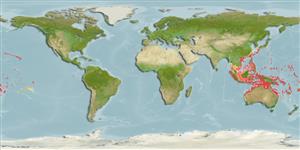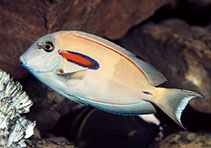Acanthurus olivaceus Bloch & Schneider, 1801
Orangespot surgeonfish
Add your observation in Fish Watcher
| Native range | All suitable habitat | Point map | Year 2050 |

|
| This map was computer-generated and has not yet been reviewed. |
| Acanthurus olivaceus AquaMaps Data sources: GBIF OBIS |
Upload your photos and videos
Pictures | Videos | Google imageAcanthurus olivaceus
Picture by Muséum-Aquarium de Nancy/D. Terver
Pictures | Videos | Google imageAcanthurus olivaceus
Picture by Muséum-Aquarium de Nancy/D. Terver
Classification / Names Nombres comunes | Sinónimos | Catalog of Fishes(Género, Especie) | ITIS | CoL | WoRMS | Cloffa
> Acanthuriformes (Surgeonfishes) > Acanthuridae (Surgeonfishes, tangs, unicornfishes) > Acanthurinae
Etymology: Acanthurus: Greek, akantha = thorn + Greek, oura = tail (Ref. 45335).
More on authors: Bloch & Schneider.
Etymology: Acanthurus: Greek, akantha = thorn + Greek, oura = tail (Ref. 45335).
More on authors: Bloch & Schneider.
Environment: milieu / climate zone / depth range / distribution range Ecología
marino asociado a arrecife; rango de profundidad 3 - 46 m (Ref. 1602), usually 9 - 46 m (Ref. 1602). Tropical; 24°C - 28°C (Ref. 27115); 35°N - 32°S, 95°E - 139°W
Distribución Países | Áreas FAO | Ecosistemas | Ocurrencias, apariciones | Point map | Introducciones | Faunafri
Pacific Ocean: Christmas Island and Cocos-Keeling Islands in the eastern Indian Ocean to the Hawaiian and Tuamoto islands, north to Japan, south to Lord Howe Island. Replaced by Acanthurus tennenti in the Indian Ocean (Ref. 37816).
Tamaño / Peso / Age
Maturity: Lm ? range ? - ? cm
Max length : 35.0 cm TL macho / no sexado; (Ref. 2334); edad máxima reportada: 33 años (Ref. 52229)
Max length : 35.0 cm TL macho / no sexado; (Ref. 2334); edad máxima reportada: 33 años (Ref. 52229)
Short description Claves de identificación | Morfología | Morfometría
Espinas dorsales (total) : 9; Radios blandos dorsales (total) : 23 - 25; Espinas anales: 3; Radios blandos anales: 22 - 24. Body of adult dark grayish brown; juveniles yellow; posterior to upper end of gill opening is a bright orange horizontal band, with purplish black border. Head and anterior half of body usually abruptly paler than the posterior half. Anterior gill rakers 24-28; posterior 23-27. Large adult males (about 17 cm) with more definite convexity of snout profile.
Inhabit seaward reefs, in areas of bare rock or mixed rubble and sand, from 9 to at least 46 m depth; juveniles inhabit protected bays and lagoons, singly or in small groups in as little as 3 m (Ref. 1602, 48637). Benthopelagic (Ref. 58302). Adults occur singly or in schools and feed on surface film of detritus, diatoms, and fine filamentous algae covering sand and bare rock (Ref. 1602). Rarely poisonous (Ref. 4795).
Life cycle and mating behavior Madurez | Reproducción | Puesta | Huevos | Fecundidad | Larva
Main reference
Upload your references | Referencias | Coordinador : Randall, John E. | Colaboradores
Randall, J.E., 1956. A revision of the surgeonfish genus Acanthurus. Pac. Sci. 10(2):159-235. (Ref. 1920)
CITES
Not Evaluated
Threat to humans
Harmless (Ref. 4795)
Human uses
Pesquerías: comercial; Acuario: Comercial
FAO - Publication: search | FishSource | Sea Around Us
Más información
Trophic ecology
componentes alimenticios
Composición de la dieta
consumo de alimento
Food rations
Despredadores
componentes alimenticios
Composición de la dieta
consumo de alimento
Food rations
Despredadores
Population dynamics
Coeficiente del crecimiento para
Max. ages / sizes
Length-weight rel.
Length-length rel.
Length-frequencies
Mass conversion
Reclutamiento
Abundancia
Coeficiente del crecimiento para
Max. ages / sizes
Length-weight rel.
Length-length rel.
Length-frequencies
Mass conversion
Reclutamiento
Abundancia
Life cycle
Reproducción
Madurez
Maturity/Gills rel.
Fecundidad
Puesta
Spawning aggregations
Huevos
Egg development
Larva
Dinámica larvaria
Reproducción
Madurez
Maturity/Gills rel.
Fecundidad
Puesta
Spawning aggregations
Huevos
Egg development
Larva
Dinámica larvaria
Physiology
Body composition
Nutrients
Consumo del oxígeno
Tipo de natación
Velocidad de natación
Visual pigments
Fish sound
Diseases & Parasites
Toxicity (LC50s)
Body composition
Nutrients
Consumo del oxígeno
Tipo de natación
Velocidad de natación
Visual pigments
Fish sound
Diseases & Parasites
Toxicity (LC50s)
Genetics
Genética
Heterozygosity
heritabilidad
Genética
Heterozygosity
heritabilidad
Human related
Aquaculture systems
Perfiles de acuicultura
Razas
Ciguatera cases
Stamps, coins, misc.
Aquaculture systems
Perfiles de acuicultura
Razas
Ciguatera cases
Stamps, coins, misc.
Herramientas
Bio-Quiz | E-book | Guía de campo | Claves de identificación | Asistente para frecuencias de tallas | Herramienta de ciclo de vida | Mapa de puntos | Classification Tree
| Catch-MSY |
Special reports
Download XML
Fuentes de Internet
AFORO (otoliths) | Aquatic Commons | BHL | Cloffa | BOLDSystems | Websites from users | Check FishWatcher | CISTI | Catalog of Fishes: Género, Especie | DiscoverLife | ECOTOX | FAO - Publication: search | Faunafri | Fishipedia | Fishtrace | GenBank: genome, nucleotide | GloBI | Google Books | Google Scholar | Google | IGFA World Record | MitoFish | Bases de datos nacionales | Otolith Atlas of Taiwan Fishes | Acuarios públicos | PubMed | Reef Life Survey | Socotra Atlas | Árbol de la vida | Wikipedia: Go, búsqueda | World Records Freshwater Fishing | Zoobank | Expediente Zoológico
Estimates based on models
Preferred temperature (Ref. 123201): 24.5 - 28.7, mean 27.3 °C (based on 356 cells).
Phylogenetic diversity index (Ref. 82804): PD50 = 0.5000 [Uniqueness, from 0.5 = low to 2.0 = high].
Bayesian length-weight: a=0.02630 (0.01711 - 0.04044), b=3.00 (2.88 - 3.12), in cm total length, based on LWR estimates for this species & Genus-body shape (Ref. 93245).
Nivel trófico (Ref. 69278): 2.3 ±0.17 se; based on food items.
Generation time: 1.0 ( na - na) years. Estimated as median ln(3)/K based on 1 growth studies.
Resiliencia (Ref. 120179): Muy bajo, población duplicada en un tiempo mínimo superior a 14 años (tmax=33).
Fishing Vulnerability (Ref. 59153): Low vulnerability (18 of 100).
Nutrients (Ref. 124155): Calcium = 69.2 [29.5, 211.4] mg/100g; Iron = 0.926 [0.341, 2.370] mg/100g; Protein = 18.5 [17.2, 19.7] %; Omega3 = 0.109 [0.049, 0.238] g/100g; Selenium = 23.8 [8.1, 73.5] μg/100g; VitaminA = 23.6 [5.9, 93.8] μg/100g; Zinc = 2.68 [0.83, 4.91] mg/100g (wet weight);




